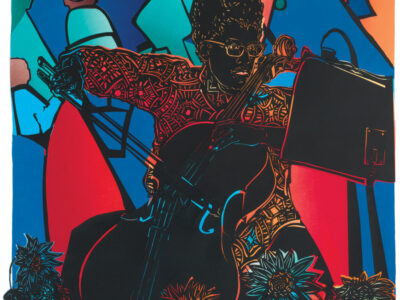There are a number of reasons why Lynn Marsden-Atlass was willing to leave her job as senior curator at the Pennsylvania Academy of Fine Arts (PAFA) to become the new director and curator of the Arthur Ross Gallery.
For one thing, she likes the university setting.
“I had in the past worked within a university community, and Penn has an extraordinary community, with great intellectual and artistic strengths,” Marsden-Atlass told the Gazette shortly after beginning her new job on March 3. (She was referring to her stint as associate director and registrar of the Colby College Museum of Art from 1989 to 1999 and, presumably, to her time as director of the Consortium of Colleges Abroad in Paris for eight years before that.)
For another, she likes the Arthur Ross Gallery itself, for the “humanist scale” and the flexibility that it offers. “It’s a remarkable gallery for its multiculturalism, for its variety of exhibitions, and its really fine publications,” she said. “It’s a gallery that can be imaginative—one exhibition can be contemporary, another can be textiles, another East Asian or Asian—and that’s what I love. I like to collaborate with artists and with curators and collectors, and basically go off and create wonderful exhibitions, so it’s a great opportunity.
“I was also intrigued by what Dilys had been able to develop with Arthur Ross and the [Arthur Ross] Foundation and Gallery over the past 20-some years,” she added, referring to Dr. Dilys Winegrad Gr’75, her predecessor, who stepped down at the end of last year [“Arts,” Jan|Feb]. “Dilys really grew the gallery to its current reputation, and I think she did a fabulous job.”
Given her affection for Philadelphia as well as for the university environment, it’s not surprising that she is hoping to “engage the University community and the greater Philadelphia community as well.” Though she had only been on the job for less than a week, she had already had some very preliminary conversations with Penn Museum director Richard Hodges and ICA director Claudia Gould about possible collaborations.
“It’s my goal, my dream to have Wharton students be interested in coming to exhibitions as much as undergraduate students in photography or someone from the medical school,” she said. “One of the problems I think all museums are facing is the ability to connect with audiences. Students are very hooked into communicating and receiving information in technological ways. So this gives them firsthand access to primary materials from every different culture.”
At the PAFA, Marsden-Atlass curated some important exhibitions, including “In Private Hands: 200 Years of American Painting,” and “Thomas Eakins and His Legacy,” along with major shows of artists such as Cecilia Beaux, Charles Demuth, Daniel Garber, Alex Katz, and Robert Motherwell. She also served as curator of American and Contemporary Art at the Chrysler Museum in Norfolk, Virginia (1999-2003), and has been a consultant and advisor for private art collections around the country. While coming to Penn is “not necessarily a logical step,” she said, “it uses the skills that I’ve developed over the years.”
On the whole, Penn’s wealth of artistic and cultural activities “can make an important contribution to the greater Philadelphia area,” she said. “For example, in 2010, the entire city is participating in Philagrafika,” formerly known as the Philadelphia Print Collaborative. “I want to do a satellite show here, either based on their theme or a print show that ties into their activities. It’s a way to connect with the city, for us to tie in to other institutions, other university galleries and national museums, et cetera.
“I very much believe that art should touch all people, and bring fun stuff to the whole Philadelphia community,” Marsden-Atlass added. “There are a lot of children who don’t get to see a lot of art—and a lot of senior citizens, too. We’ve got a great opportunity there.”
—S.H.




